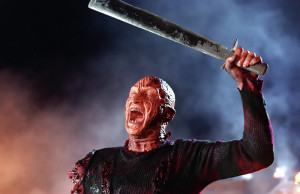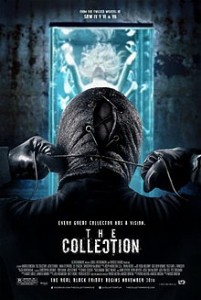PEELERS Review: This Zombie/Stripper Film Isn’t APEEL-ing, it’s Appalling.
Review copy provided courtesy of October Coast Publicity
I like zombies. I like strippers. So it seems zombie-strippers would be (pardon the pun) a no-brainer. But 2008’s Jenna Jameson/Robert Englund film Zombie Strippers fell in its high heels. 2012’s Zombies Vs Strippers failed to get a rise out of me. And defying my expectations, Sevé Schelenz’s new film Peelers is even worse than those two previous efforts.
Peelers’ concept is simple enough. When four coal miners accidentally strike oil they head to the Titty Balls Strip Club to celebrate. And it’s the club’s last night as owner “Blue” Jean Douglas, played by Wren Walker, has sold the club to a land developer who plans to shut it down. Soon their night of revelry turns into revulsion as the black ooze infected the miners turning them into bloodthirsty, mindless killers. No one in the club is safe, and the infection is spreading.
This set-up seems like a perfect throwback to ‘80s slasher films. I had low expectations for Peelers, but if it could give me base genre thrills along the lines of Prom Night 3 (yeah, part 3, not even part 1) or Friday the 13th Part VIII: Jason Takes Manhattan I would have given this film a solid recommend.
Sure enough, the film’s set-up seems to indicate that’s what I’ll get as we’re introduced to owner “Blue Jean”, her bad-boy brother Logan (Madison J. Loos), and the various strippers, bouncers, bartenders, and cooks that populate the Titty Balls. Instantly we see a large cast we know will lead to a decent body count. And it doesn’t take long before the miners arrive, and one begins regurgitating and transforming into a zombie.
And I was jazzed by some comic book cred. One character is named Logan, and another is Remy. I could chalk that up to a coincidence, but when the bartender drops a line about adamantium it’s obvious writer Lisa DeVita is an X-Men fan.
From there all the film had to do was coast on “cruise control” and give me some inventive kills along the way. Unfortunately first-time screenwriter DeVita can’t even accomplish that.
The set-ups in this film are so obvious I thought DeVita was trying to be funny. In the first fifteen minutes of the film we are introduced to what I can only call Chekhov’s arsenal: the strip club has a baseball bat, several handguns, and even, improbably enough, a chainsaw. Clearly every awkwardly-shown item will (and does) lead to later zombie defense.
But soon I realize the script wasn’t being ironic, it’s just poor. The plotting is confusing in several ways. For example, the miners believe they found oil, but it smells awful and converts them to zombies. Yet later we’re told it is still actual oil that can fuel your vehicle…and turn you into the living dead?
Beyond ridiculous, the script is downright ignorant. (Minor spoiler) The kryptonite for these oil monsters isn’t a gunshot to the head, it’s….water? The rationale is “Water and oil don’t mix” so, obviously, water will kill these bloodthirsty beasts?
Unlikely as it seems, the stupidity only escalates from there! The survivors in the club could just run away, but “Blue Jean” marshals them to stay and fight, lest these monsters go to the general population. Yet no one realizes that if they just wait out one good rainstorm then the problem will take care of itself.
Additionally, this group has every weapon known to god and man, but not one person has a cell phone?
If I gave the film the benefit of the doubt I’d say this was all intentional humor, but the leaden dialogue delivered by a cast of complete unknowns makes it all seem deadly serious. And deathly boring.
Yet I found myself slightly impressed with the production. Post-viewing research told me Peelers was a Kickstarter-funded film made for about $20,000. For that small sum Peelers achieved quality sound work, and decent camerawork. I looked up cinematographer Lindsay George and he has over a decade’s work on shorts and television. The result is a professional looking production that seems to make spectacular work of existing lights, and good effect of digital video cameras that work well in low-light conditions.
Some of the gore effects are also passable for cheapie-horror.
But if I’m complimenting a movie for saying it’s well lit, I’m stretching to find compliments. George is a good cameraman but he had nothing good in front of the camera to film. And several times he’s let down by poor staging and editing that makes action scenes downright confusing.
If you’re only requirement for this film is gratuitous nudity, yes, you’ll find it here, but every single bit of it is undercut by the most repugnant of “humor.” One stripper does her dance, only to end by giving guys in the front row a golden shower. Another stripper is late into her third trimester. I’ve been to a couple dive clubs in my life, but this is simply grotesque.
And yes, one zombie is indeed killed when the pregnant stripper’s water breaks on his head. If you think that sounds cool, you’ll still be bored as hell by Peelers.
It takes a lot to revolt me. The strippers here pulled it off. So…congratulations? But it wasn’t even in the fun Human Centipede way. More in the vein of “no one should have to watch this.”
Finally, the title Peelers was misleading. From the poster, showing an amputated stripper, and the title I thought I’d be watching a film about creatures that peel the skin off their victims. It would be the ultimate strip-club irony–a monster that continues to “undress” their nude victims. But these beasts just bite and gouge. The title, I suppose, references the strippers, but I’ve never heard a dancer called a “peeler” before. I suppose it’s a shame the title Striptese, Zombies vs Strippers, Zombie Strippers, Showgirls, and Zombeavers were taken. (FYI, every single movie listed there is more enjoyable than Peelers).
The end result is a film that seems to think it’s a cheapie From Dusk ‘Til Dawn rip-off, and ends up being so much worse than either of Dawn’s direct-to-video sequels. It’s not even fun in a so-bad-it’s-good way. It’s a mind-numbing 90 minutes that I will never get back.
The cover art reads “You may not get the happy ending you were looking for.” I certainly didn’t. Neither will anyone who watches this imbecilic production.
Congratulations to the film crew for accomplishing what they did on so little budget, but next time perhaps give that script a second draft before you start shooting.
July 14, 2017 Posted by Arnie C | Movies, News, Reviews | horror, Movie, Movies, News, Now Playing, Now Playing Podcast, Podcasts, Review, Reviews, Romero, Slasher, Strippers, Zombies | Comments Off on PEELERS Review: This Zombie/Stripper Film Isn’t APEEL-ing, it’s Appalling.
Soundtracks on Vinyl: You’re Next
One of the draws to collect vinyl releases of movie scores and soundtracks is the large artwork for the film that accompanies it. These entries will review the vinyl record release of a film score/soundtrack from the music to the artwork, as well as the film…
The Movie
You’re Next tells the story of a well-to-do family getting together in their home in the woods for a reunion. However, none of them seem very excited to see each other. Their ambivalence soon turns to terror and fear as a gang dawning animals masks invades the home and starts killing off members of the family. But the intruders meet resistance when one guest displays a special set of skills for fighting back.
I’m not one for slashers, but the striking posters for the film caught my attention. Each poster featured the close up of one of the intruders in a plastic animal mask (the lamb mask always stuck out to me) with You’re Next written out as painted in blood. Even the title had a simplicity that immediately expressed the mood of the film (it’s appeal similar to the title of Simon Pegg’s fake Grindhouse trailer for Don’t).
February 26, 2016 Posted by jakob | Movies, Music, Now Playing Podcast | horror, Movie, Review, Score, Slasher, Soundtrack, Vinyl, You're Next | Comments Off on Soundtracks on Vinyl: You’re Next
The 40 Year-Old-Critic: Freddy vs. Jason (2003)
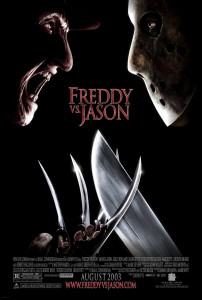 In The 40-Year-Old Critic, Venganza Media creator and host Arnie Carvalho recalls a memorable film for each year of his life. This series appears daily on the Venganza Media Gazette.
In The 40-Year-Old Critic, Venganza Media creator and host Arnie Carvalho recalls a memorable film for each year of his life. This series appears daily on the Venganza Media Gazette.
How many times will I review Freddy vs. Jason? It was one of Now Playing Podcast’s earliest reviews as part of our first retrospective series covering the Friday the 13th franchise leading up to the 2009 remake. Even then we planned to revisit the film and look at it from Freddy’s point of view, which we did the following year during the review series leading up to 2010’s A Nightmare on Elm Street.
By now this should be well-trod ground, and what more could I have to say?
Yet the fact that this is the only movie to be covered twice in Now Playing Podcast retrospectives is indicative of its importance — to film in general and to me personally.
Since our 2010 review I’ve spent a lot more time thinking about the crossover. What is it about two franchises coming together that creates such excitement, especially in the “geek” community? I don’t ask this hypothetically. I personally get swept up in the frenzy when two franchises come together, and it doesn’t even matter necessarily if I like them both! The thought of two universes colliding seems to have a geometric, not additive, increase in interest.
I think to some degree it is fan rivalry at its best. For reasons I don’t understand it seems some fans feel the only way to feel good about their fandom is by putting down others. For example, when Firefly was at its zenith a parade of “Joss Whedon Is My Master Now” shirts filled Star Wars conventions, as if to say, “Star Wars used to be cool.” As such, the “my dad can beat up your dad” mentality started to apply to fan groups; “My stormtrooper can beat up your browncoat.”
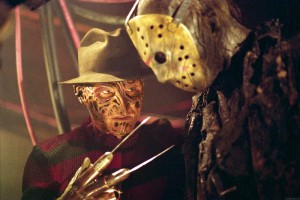
Freddy vs. Jason — whoever loses, the fans win.
That question of who would win in a fight certainly applies to superheroes. In real life, on screen, and online I’ve heard endless debates about which hero is faster, The Flash or Superman. Who would win in a fight, Superman or The Hulk? It is a curiosity, but the chosen winner usually aligns with the speaker’s fan allegiances.
Certainly, speaking of superheroes, comic books have benefited greatly from the crossover. DC Comics had a major hit with its Justice League in 1961, prompting Marvel Comics to respond with its own super team, The Fantastic Four, a move that inadvertently launched the entire Marvel Universe.
Yet, to me, the crossover seemed relegated to just that medium — the comic book. It seemed comics were pulp enough that you could do anything.
Aliens vs. Predator? Sure.
Robocop vs. Terminator? Why not.
Star Trek and X-Men together, you say? Absolutely.
Even rivals Marvel and DC had several crossover series’ that, for instance, led to Superman meeting Spider-Man or Batman fighting the Hulk.
Despite the success and excitement generated by these crossover comics, the concept was rarely conceptualized on film. Universal Studios had done it in the 1940s, when horror icons Dracula, Frankenstein and the Wolf Man came together for the studio’s “Monster Mash” pictures. But Universal owned each property, and when that series ended, crossovers on screen were scarce.
I can recall two that made an impact on me.

Freddy and Jason aren’t the only names in this cast. Monica Keena (Dawson’s Creek), Katharine Isabelle (Ginger Snaps), and Destiny Child’s Kelly Rowland play teens caught in the middle of the battle royale.
I remember being a young child on vacation with my parents when I saw a trailer for King Kong vs. Godzilla. I had seen numerous Godzilla films, and the 1976 King Kong several times. So the thought of them fighting broke my fragile little mind. I demanded we stay in the hotel room that night so I could watch.
Then, in 1988, Who Framed Roger Rabbit brought together animated characters from Warner Bros., Disney, Turner Entertainment, and more. As I was a teenager, and never really into these characters at my youngest age, the impact was totally lost on me. I saw the film in theaters, thought it was mediocre, and haven’t seen it since.
Beyond those two I can’t think of any groundbreaking crossovers. Some minor ones occurred; such as Star Trek: Generations bringing together cast members from two Trek television series’ (something that had already been done numerous times on Star Trek: The Next Generation, thus lessening the film’s impact). Also, The Monster Squad reassembled the classic Universal Monsters for a kiddie comedy.
But fans wanted more.
So many ideas were teased. Studios knew what we liked, so 1997’s Batman and Robin made sly references to Superman, and 20th Century Fox put an Alien xenomorph skull on a Predator ship in Predator 2. The latter seemed most likely to happen again on film — both franchises were Fox properties in need of a boost. Yet, outside of the Dark Horse comics, nothing materialized for years.
For me, though, more than Aliens and Predators, more than Superman and Batman, Freddy and Jason were the two I wanted to see. Long had the rumor brewed about Hollywood’s (then) top-grossing slashers, Jason Voorhees and Freddy Krueger, going toe-to-toe. I read about it in multiple Fangoria articles in the late 80s and early 90s.
I first saw A Nightmare on Elm Street during a party in 1987, around the time of A Nightmare on Elm Street 3: The Dream Warriors’ release. I found the films so inventive and fun that I rewatched them endlessly, and anxiously awaited each new installment in the series. As detailed during the Now Playing Podcast review, I even cosplayed for the release of Freddy’s Dead: The Final Nightmare. By 2003 I was happy for any new Nightmare, let alone one that pitted villain Freddy against Friday the 13th icon Jason.
I was never as big a fan of the Crystal Lake zombie as I was Freddy, but I did also enjoy the Friday the 13th series. Some of the first R-rated horror I ever saw was Friday the 13th when I came home to find older kids in my house watching it. I tried to join them but the carnage, specifically the decapitation at the end of the 1980 original film, had me fleeing the room. When I finally became a full-fledged horror hound in my early teen years I returned to the franchise when Jason Takes Manhattan was released. While the films lacked the visual panache of the Nightmare series I still enjoyed the films as a guilty pleasure. Over time the series grew in my esteem to be another favorite.

Freddy was killed by fire, but flames don’t slow down Jason.
As such, having both serialized slashers come together would be a dream come true. Or, if done wrong, perhaps a nightmare.
Yet despite the rumors in the horror press and the anticipation by fans such as myself, the killer crossover took 15 years to materialize. Full credit for finally bringing the crossover to screen in the 21st Century must be given to New Line Cinema.
The biggest problem in the 1980s and 1990s was the rights: Jason was owned by Paramount, Freddy was New Line Cinema’s cash cow. The studios tried to work together during the slasher heyday but each wanted to earn 100 percent of the profits by licensing the other’s character. Obviously, that never happened.
Eventually, though, profits started to dry up. Paramount had run Friday the 13th into the ground with crazy concepts like Jason fighting a telekinetic or taking Manhattan. When original Friday creator Sean S. Cunningham wanted to see the franchise continue, specifically with a Freddy crossover, Paramount had no interest. This gave New Line an opportunity. They licensed Jason from Paramount and went to work on Freddy vs. Jason.
While Jason’s creator wanted the crossover, Freddy creator Wes Craven had other ideas. The Springwood Slasher had been given what New Line considered a proper sendoff with 1991’s Freddy’s Dead: The Final Nightmare. But the sequel proved profitable and Craven started planning a return to his iconic franchise. As such, Freddy vs. Jason was put on hold and, instead, Wes Craven’s New Nightmare was made.
Cunningham bided his time, though. In 1993 Jason Goes to Hell: The Final Friday was released and ended with a fan-baiting stinger; Freddy’s glove comes out of the ground and pulls down Jason’s mask. The game was afoot!
We would still have to wait more than a decade for Freddy and Jason to properly share the screen. New Line executives knew the importance of finding the perfect balance between the two famous killers, and so more than a dozen pitches were drafted and subsequently rejected.
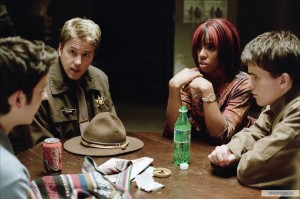
More victims caught in the middle of the killer clash.
Eventually I gave up all hope on Freddy vs. Jason. Nightmare star Robert Englund had not put on the makeup in almost 10 years and I thought Freddy would never grace the screen again. Jason, meanwhile, had gone to space with Jason X (which sat on a shelf for 2 years before its release). Finally, in the early part of the last decade, news — real news — started to come out that the movie was being made.
I honestly believe my excitement for Freddy vs. Jason was on par with my feelings about 1999’s Star Wars Episode I. A countdown clock sat on my computer desktop for 4 months, and when the day finally came I took an afternoon off work to see the first showing.
It met my every expectation.
Directed by Bride of Chucky’s Ronny Yu, the film was outrageous, gory, and over-the-top fun. Both characters got their due (even if Jason inexplicably was suddenly afraid of water) and I couldn’t have asked for more. You can hear a blow-by-blow analysis and both of my reviews at the Now Playing Podcast website, but in short I gave it a strong recommend both times.
Yet loving a movie isn’t enough to garner inclusion in this 40-Year-Old Critic series, there has to be a long-lasting impact. For Freddy vs. Jason, there were two.
First, this film gave Robert Englund a proper Freddy sendoff. It was the best film starring the dream stalker since 1988’s The Dream Master. It cemented a positive feeling for the Nightmare franchise that remains unsullied to this day. Just two weeks ago I had my photo taken with Englund, who was dressed in the full Freddy make-up. I even have ideas for a Nightmare inspired tattoo–the dream killer’s glove slicing into my skin.

Freddy vs. Arnie — Robert Englund and Arnie pose for a photo at Flashback Weekends in Aug. 2014
Second, though, Freddy vs. Jason’s success launched more than a decade of franchise crossovers. The next year finally saw the release of Alien vs. Predator, which I anticipated every bit as much as Freddy vs. Jason — and which was an utter letdown.
Other pictures released that year include the low-rent, made-for-television crossover Puppet Master vs. Demonic Toys (co-written by Blade and The Dark Knight scribe David Goyer), as well as a return to the “Monster Mash” formula with Universal’s Van Helsing.
Yes, the track record for crossovers wasn’t stellar, but that was honestly my secondary concern — the primary concern was that they were happening. Finally, after decades of teasing, universes were being shared and the world of movies suddenly felt as open as the page of a comic book. But, after 2007’s Aliens vs. Predator: Requiem a shot of adrenaline was needed. I do think the crossover was starting to be seen as desperate, until Marvel Studios took it to the next level.
In 2008 Marvel released its first movie produced in-house: Iron Man. The film stood alone, introducing wide audiences to a superhero that was considered B-list at best. Yet Marvel took a page from New Line Cinema’s book: at the very end Nick Fury showed up to discuss “The Avengers Initiative.” This was the comic book equivalent of Freddy’s hand bursting up from the ground, and Marvel kept its momentum building toward the third-highest-grossing film of all time: The Avengers.
There is a direct lineage from Jason Goes to Hell to Iron Man, from Freddy vs. Jason to The Avengers.
So next spring when you buy your ticket for The Avengers: Age of Ultron (and then download the Now Playing Podcast review) think about the trailblazer that pioneered the modern crossover film: Freddy vs. Jason.
Tomorrow — 2004!
Arnie is a movie critic for Now Playing Podcast, a book reviewer for the Books & Nachos podcast, and co-host of the collecting podcasts Star Wars Action News and Marvelicious Toys. You can follow him on Twitter @thearniec
September 2, 2014 Posted by Arnie C | 40-Year-Old Critic, Comic Books, Conventions, Movies, Now Playing Podcast, Podcasts, Reviews | 1980s, 1990s, 2000s, 40-Year-Old Critic, Avengers, Comic Books, Comics, Crossover, Enertainment, Film, Freddy, Friday the 13th, horror, Iron Man, Jason, Movie, Movies, Nightmare on Elm Street, Now Playing, Now Playing Podcast, Podcasts, Review, Reviews, Ronnie Yu, Sean S. Cunningham, Slasher, Wes Craven | Comments Off on The 40 Year-Old-Critic: Freddy vs. Jason (2003)
The 40 Year-Old-Critic: Scream (1996)
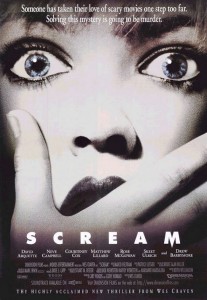 In The 40-Year-Old Critic, Venganza Media creator and host Arnie Carvalho recalls a memorable film for each year of his life. This series appears daily on the Venganza Media Gazette.
In The 40-Year-Old Critic, Venganza Media creator and host Arnie Carvalho recalls a memorable film for each year of his life. This series appears daily on the Venganza Media Gazette.
What’s your favorite scary movie?
As I mentioned in previous reviews of Love at First Bite and Hellbound: Hellraiser II, I have always been a horror fan.
As a very young child I loved the fear I felt toward forbidden cinema, and as I aged I came to see the humor, thrills, and scares in the genre. In my 20s, though, my love of horror changed. I had grown up and no longer had exciting nightmares starring Freddy Krueger. To me, there were no more mysteries in the world, and no more scares to be had on screen.
This problem was exacerbated by a lack of exciting horror in theaters. The slasher craze of the 80s had waned with Friday the 13th Part VIII: Jason Takes Manhattan and Freddy’s Dead: The Final Nightmare. By the early 90s the genre seemed to be gasping its last breaths; Jason Goes to Hell: The Final Friday was the 1993’s top-grossing horror film with only $15 million — nearly tying Manhattan’s $14 million for a series low. A year later the only notable horror release in theaters was Wes Craven’s New Nightmare. By the time The Mangler and Halloween: The Curse of Michael Myers came and (quickly) went, it seemed the bloody fun of the cinema was gone.
At the same time Hollywood was failing to launch new horror stars on screen. The first Leprechaun was released to little fanfare, and audiences simply laughed off Dr. Giggles.
I still enjoyed horror where I could find it, but that was mostly on direct-to-VHS releases. There was the occasional gem, such as Return of the Living Dead 3, or Tales from the Crypt Presents Bordello of Blood, but it was largely a parade of dreck.
I thought horror was dead.
But like any good villain, horror came back from the dead in the holiday season of 1996. The best gift I received that Christmas was an unexpected revival! Suddenly horror was cool again, and the film that made it happen was Scream.

If Ghostface had narrowed the scope to “What’s your favorite scary movie from 1990 to 1995” I think his victims would still be trying to find one.
Even though I’d let my Fangoria subscription lapse, I’d kept up with horror film production in the 90s. I knew that Wes Craven, creator of the A Nightmare on Elm Street franchise, was working on a new slasher film… and I wanted nothing to do with it.
Though I idolized Craven growing up, due exclusively to the Nightmare series, the director’s later works were crap.
I was unimpressed and felt betrayed by Craven’s incoherent and bloodless 1989 slasher Shocker — though I have since come to love the film for the over-the-top “schlocker” that it is. Then in 1991 I raced opening weekend to see The People Under the Stairs, and was simply bored.
I still didn’t learn. I became ecstatic when I heard Craven’s next film would be a return to the Elm Street series, the director promising to make Freddy frightening once again. When I walked out of Wes Craven’s New Nightmare I felt I had seen my last Craven film. You can hear my full New Nightmare review in the Now Playing Podcast archives, but I truthfully wondered how I ever idolized this man who seemed able to only make terrible movies.
That line of thought was cemented with 1995’s Eddie Murphy horror comedy Vampire in Brooklyn, a film I saw out of devotion to Murphy, not Craven.
So in 1996, hearing Craven was going to make a new horror film was actually a turn-off. In ‘96 I would have rather gone to theaters to see Lawnmower Man 2: Beyond Cyberspace than Craven’s Scream.
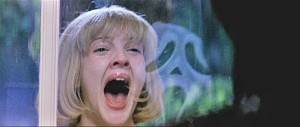
Scream turned Barrymore into an A-list star once again.
The cast did nothing to change this impression. Press materials touted Drew Barrymore’s role, and that seemed a bad sign. Back then she was still the little girl from E.T. who, like so many child stars, had developed a dependency problem. While I had seen her work in Boys on the Side and Mad Love I thought her heyday was behind her; the only roles she had in major releases were bit parts in Wayne’s World 2 and Batman Forever. She seemed “over” in Hollywood. I would never have guessed that, thanks to Scream, Barrymore was poised for a return to superstardom.
The rest of the cast — actors I’d not heard of or knew only from television shows — also failed to grab my attention. The only cast member that caught my interest was Matthew Lillard, whose zany performance I’d loved in Hackers, yet that was not near enough for me to want to see this movie in theaters.
Most of all, the film’s trailers didn’t hook me. I thought the killer’s mask was silly — had Michael Myers and Jason Voorhees taken all the good killer masks? I admit I was intrigued by the thought of characters that knew horror movie tropes; I mean, this was a horror movie where the characters were people like me. Still, with Craven’s name on the poster I wanted nothing to do with it.

Lillard would go on to the Scooby Doo films after himself being unmasked as the bad guy in Scream.
I saw Scream in theaters only because I was invited by a group of friends and my options were to go to this movie or stay home alone. I wasn’t happy about going, and I anticipated a wholly miserable People Under the Stairs type of experience.
To say I was won over is an understatement. The film did have a good deal of true horror, with the opening murder scene a suspenseful highlight. With the scares firmly established, the movie achieved a near-perfect balance between self-referential humor and legitimate tension. While, due to my age, I was not afraid, the film did succeed in making me jump a couple of times.
In 2011 I gave my full review of Scream as part of our retrospective series leading up to Scream 4, so I will not repeat myself here. You can listen to that full review for a blow-by-blow analysis by Stuart, Marjorie and myself.
In short, not only did Scream win me over; I feel it is Craven’s best film — even better than my beloved A Nightmare on Elm Street.
I believe Craven was greatly assisted by the script from first-time screenwriter Kevin Williamson. Having seen many films made from Craven-penned scripts, none come near Scream in terms of plot twists, fleshed-out characterizations, and careful plotting. The movie was a whodunit, something I didn’t expect in a slasher. After all, in most slashers I knew the killer was Freddy or Michael or Jason or Chucky. That the killer was one of the kids was a fun experience — me trying to outwit the characters and peg the killer. When the mask is removed and the full story revealed, even I was taken aback by some of the twists. This is all Williamson, and I give him full credit for the film’s quality.
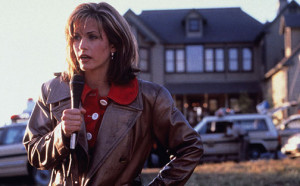
I watched Friends, but never saw Cox as a good fit for horror. Again, I was wrong.
Yet I cannot overlook Craven in the director’s chair. While the script was great, Craven brought two decades of horror experience to Scream. He knew how long to hold a moment, how to reveal a body, and how to build tension that would climax with a jump scare.
My heart was racing as I left the theater. This was the first great original horror film I’d seen in many years, yet had I known the long-lasting impact Scream would have, my exuberance would have been even greater.
The movie went on to make nearly $175 million on a $15 million budget, reminding Hollywood that a good horror movie can provide substantial returns.
Scream single-handedly revived the entire horror genre. The next year gave us not only Scream 2, but also — thanks to Williamson’s success — the enjoyable, but forgettable, I Know What You Did Last Summer.
We also got the Wes Craven-produced Wishmaster, which I saw in theaters and found a weirdly awful throwback to the days of Leprechaun.
By 1998, other studios had caught on and the post-modern, self-aware horror film had its heyday with Bride of Chucky, Halloween H20, Urban Legend and The Faculty. The quality was mixed, but all were far better films than Lawnmower Man 2 or The Curse of Michael Myers.
Scream made me appreciate Craven’s ability, but even more its success spawned dozens of films I’ve enjoyed over the past 20 years. For that reason alone, if not just for the movie itself, Scream might just be my favorite scary movie.
Tomorrow — 1997!
Arnie is a movie critic for Now Playing Podcast, a book reviewer for the Books & Nachos podcast, and co-host of the collecting podcasts Star Wars Action News and Marvelicious Toys. You can follow him on Twitter @thearniec
August 26, 2014 Posted by Arnie C | 40-Year-Old Critic, Movies, Now Playing Podcast, Podcasts, Reviews | 1990s, 40-Year-Old Critic, A Nightmare on Elm Street, Enertainment, Film, horror, Kevin Williamson, Movie, Movies, Now Playing, Now Playing Podcast, Podcasts, Review, Reviews, Scream, Slasher, Wes Craven | Comments Off on The 40 Year-Old-Critic: Scream (1996)
The Collection Movie Review
The Collection
Director: Marcus Dunstan
Writer: Marcus Dunstan, Patrick Melton
Starring: Josh Stewart, Emma Fitzpatrick Christopher McDonald, Lee Tergesen, Randall Archer
Studio: Fortress Features Features
Release Date: September 21, 2012
Elaborate, fatal traps? Squirm inducing injuries? Copious blood? Combine these features with a sadistic and mysterious killer and you’ve got The Collection, a sequel to The Collector. The Collector was initially written as a prequel to Saw. When it was rejected, it became its own movie outright, spawning this franchise.
Arkin, having escaped from The Collector, is tapped by a private security team to tell them where he was held captive so that they can rescue Elena, the latest victim. He’s forced at gunpoint to enter the abandoned hotel that is the villain’s lair, in order to make sure that they get their target. As the team is picked off by the deadly concealed ambushes, they are astounded by the grotesque acts The Collector has committed to his victims.
The Collector likes to kill his victims using fancy mouse (human?) traps. Try to escape through a window and you’re likely to have your hand sliced off when you open it. Step on a certain spot on the floor and large spears will impale you. There’s a dotted line in the horror movie family tree from Jigsaw to The Collector. They seem fairly similar in operations. But The Collector lacks a motive. The novelty of Jigsaw was that he offered his victims a chance at redemption. Freeing oneself from the contraption was also freeing yourself from your past. There is nothing hidden here, these exist solely to kill. There is no redemption for any of the victims. The contraptions are not elaborate as they were in the Saw series. These try but they come off more as a deadly Home Alone movie.
The one thing this film does both very well is the character of The Collector. He is incredibly menacing as we have never seen his face nor has he ever spoken. He lurks, stalks and grabs with the precision of Michael Myers. He’s very mysterious with his lucha libre like mask and insect collection. The potential for a great serial killer is there with all of this covertness, but he is too unknown. There just aren’t enough character details to make him a great antagonist. Other than he collects one person to keep from every killing spree, we don’t know anything else about him. He’s portrayed as cryptic for cryptic sake but for no good reason. It was unfulfilling to know so little.
Instead of paying homage to the granddaddy of torture porn, The Collection comes off like a made for TV copycat movie. It’s similar enough to remind the viewer of its roots but it has just enough differences to escape plagiarism. There wasn’t enough originality to make this work and let’s be honest, if you’re going to emulate another franchise, do it bigger, badder and better. Although the murderer has potential, his details aren’t revealed enough to make him add anything more than a frustration. Even with razor blades held to my face, I wouldn’t recommend this movie.
April 10, 2013 Posted by Arnie C | Movies, Now Playing Podcast, Podcasts, Reviews | horror, Movie, Now Playing, Review, Slasher, The Collection, The Collector, Torture Porn | Comments Off on The Collection Movie Review
-
Archives
- February 2021 (1)
- January 2021 (1)
- December 2020 (1)
- November 2020 (3)
- October 2020 (2)
- September 2020 (1)
- August 2020 (2)
- July 2020 (1)
- June 2020 (1)
- May 2020 (1)
- April 2020 (3)
- March 2020 (2)
-
Categories
-
RSS
Entries RSS
Comments RSS
Site info
Venganza Media GazetteTheme: Andreas04 by Andreas Viklund. Get a free blog at WordPress.com.

